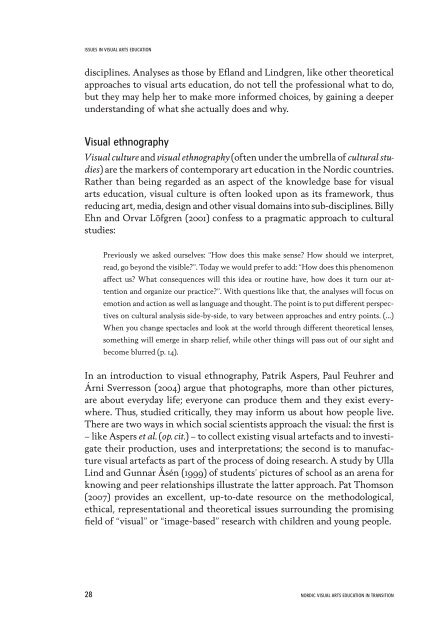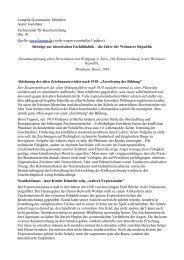Research in Visual Arts Education - The National Society for ...
Research in Visual Arts Education - The National Society for ...
Research in Visual Arts Education - The National Society for ...
You also want an ePaper? Increase the reach of your titles
YUMPU automatically turns print PDFs into web optimized ePapers that Google loves.
ISSUES IN VISUAL ARTS EDUCATION<br />
discipl<strong>in</strong>es. Analyses as those by Efland and L<strong>in</strong>dgren, like other theoretical<br />
approaches to visual arts education, do not tell the professional what to do,<br />
but they may help her to make more <strong>in</strong><strong>for</strong>med choices, by ga<strong>in</strong><strong>in</strong>g a deeper<br />
understand<strong>in</strong>g of what she actually does and why.<br />
<strong>Visual</strong> ethnography<br />
<strong>Visual</strong> culture and visual ethnography (often under the umbrella of cultural studies)<br />
are the markers of contemporary art education <strong>in</strong> the Nordic countries.<br />
Rather than be<strong>in</strong>g regarded as an aspect of the knowledge base <strong>for</strong> visual<br />
arts education, visual culture is often looked upon as its framework, thus<br />
reduc<strong>in</strong>g art, media, design and other visual doma<strong>in</strong>s <strong>in</strong>to sub-discipl<strong>in</strong>es. Billy<br />
Ehn and Orvar Löfgren (2001) confess to a pragmatic approach to cultural<br />
studies:<br />
Previously we asked ourselves: “How does this make sense How should we <strong>in</strong>terpret,<br />
read, go beyond the visible”. Today we would prefer to add: “How does this phenomenon<br />
affect us What consequences will this idea or rout<strong>in</strong>e have, how does it turn our attention<br />
and organize our practice”. With questions like that, the analyses will focus on<br />
emotion and action as well as language and thought. <strong>The</strong> po<strong>in</strong>t is to put different perspectives<br />
on cultural analysis side-by-side, to vary between approaches and entry po<strong>in</strong>ts. (…)<br />
When you change spectacles and look at the world through different theoretical lenses,<br />
someth<strong>in</strong>g will emerge <strong>in</strong> sharp relief, while other th<strong>in</strong>gs will pass out of our sight and<br />
become blurred (p. 14).<br />
In an <strong>in</strong>troduction to visual ethnography, Patrik Aspers, Paul Feuhrer and<br />
Árni Sverresson (2004) argue that photographs, more than other pictures,<br />
are about everyday life; everyone can produce them and they exist everywhere.<br />
Thus, studied critically, they may <strong>in</strong><strong>for</strong>m us about how people live.<br />
<strong>The</strong>re are two ways <strong>in</strong> which social scientists approach the visual: the first is<br />
– like Aspers et al. (op. cit.) – to collect exist<strong>in</strong>g visual artefacts and to <strong>in</strong>vestigate<br />
their production, uses and <strong>in</strong>terpretations; the second is to manufacture<br />
visual artefacts as part of the process of do<strong>in</strong>g research. A study by Ulla<br />
L<strong>in</strong>d and Gunnar Åsén (1999) of students’ pictures of school as an arena <strong>for</strong><br />
know<strong>in</strong>g and peer relationships illustrate the latter approach. Pat Thomson<br />
(2007) provides an excellent, up-to-date resource on the methodological,<br />
ethical, representational and theoretical issues surround<strong>in</strong>g the promis<strong>in</strong>g<br />
field of “visual” or “image-based” research with children and young people.<br />
28 NORDIC VISUAL ARTS EDUCATION IN TRANSITION



